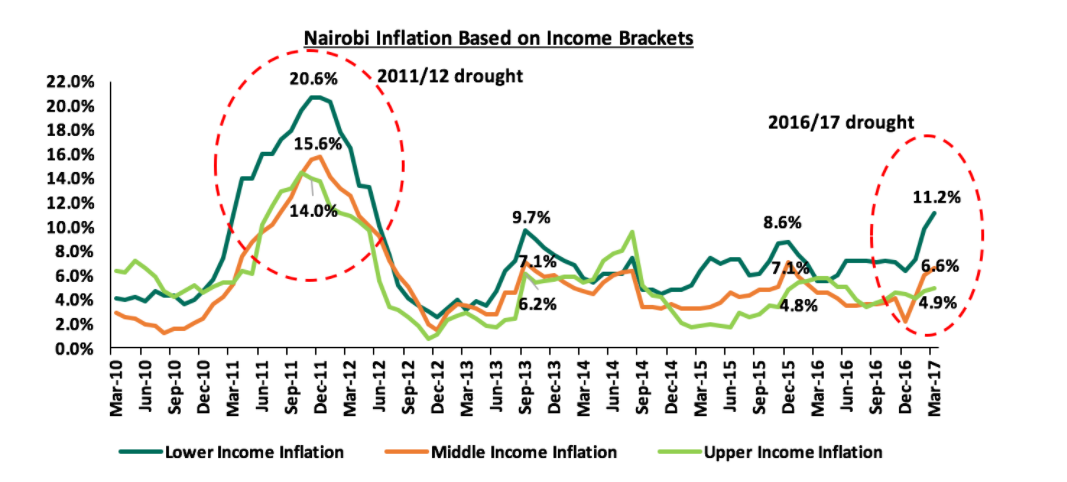High Cost of Living in Kenya and How to Curb its Recurrence in Future

The cost of living in Kenya has gone up in the past few months and most households have been forced to dig dipper into their pockets and to stretch their budgets in order to meet basic needs.
The Economic Survey 2017 from the Kenya National Bureau of Statistics (KNBS) revealed that GDP is estimated to have grown by 5.8 percent in 2016 from 5.7 percent in 2015.
The agricultural sector has been key in enabling the growth of the Kenyan economy for a long period of time, but the sector’s contribution to GDP declined by 0.4 percent to 21.8 percent and its weighted y/y growth rate slowed down to 4.0 percent from 5.5 percent in 2015. This was attributed to the drought experienced from the 2nd half of the year that rendered the weather conditions unfavorable for agricultural activities.
The growth of the financial sector also slowed down, growing by 6.9 percent in 2016 from 9.4 percent in 2015 driven by slow private sector money supply growth of 3.6 percent in 2016 from 14.1 percent in 2015, and a slump in domestic credit growth to 6.4 percent from 20.8 percent in 2015.
These two prevailing conditions have had an effect on the cost of living. In the country according to the weekly report from Cytonn Investments Company. Cost of living is simply what one needs to sustain their daily needs and is a function of one’s disposable income and one’s expenses.
The report noted that inflationary pressure has been felt more by the low middle-income people given that they spend most of their incomes on basic necessities like food whose inflation has been quite high as shown in the chart below:
To help curb recurrence of the situation at hand, Cytonn suggested some long-term solutions that included:
- Developing irrigation schemes to reduce dependence on rain-fed agriculture and ensure food security in low rainfall seasons,
- Encouraging a culture change in the population to embrace all food types and enable us to depend on drought resistant crops, such as sorghum and millet, in times that we have to,
- Better budgetary disaster management allocation,
- Diversifying sources of electricity to reduce dependence on HEP which is reliant on good rainfall,
- Investing in water reservoirs across the country to harvest rainwater and ensure water is stored for use in times of low rainfall,
- Doing more to preserve water catchment areas especially forests,
- Investing in proper national food storage facilities to enable us to store enough food for drought seasons, and
- Improving the food distribution and reservations channels in the country to ensure food moves swiftly from areas with a surplus to areas with a deficit.
About Soko Directory Team
Soko Directory is a Financial and Markets digital portal that tracks brands, listed firms on the NSE, SMEs and trend setters in the markets eco-system.Find us on Facebook: facebook.com/SokoDirectory and on Twitter: twitter.com/SokoDirectory
- January 2025 (119)
- February 2025 (191)
- March 2025 (212)
- April 2025 (193)
- May 2025 (161)
- June 2025 (157)
- July 2025 (227)
- August 2025 (211)
- September 2025 (270)
- October 2025 (297)
- November 2025 (230)
- December 2025 (112)
- January 2024 (238)
- February 2024 (227)
- March 2024 (190)
- April 2024 (133)
- May 2024 (157)
- June 2024 (145)
- July 2024 (136)
- August 2024 (154)
- September 2024 (212)
- October 2024 (255)
- November 2024 (196)
- December 2024 (143)
- January 2023 (182)
- February 2023 (203)
- March 2023 (322)
- April 2023 (297)
- May 2023 (267)
- June 2023 (214)
- July 2023 (212)
- August 2023 (257)
- September 2023 (237)
- October 2023 (264)
- November 2023 (286)
- December 2023 (177)
- January 2022 (293)
- February 2022 (329)
- March 2022 (358)
- April 2022 (292)
- May 2022 (271)
- June 2022 (232)
- July 2022 (278)
- August 2022 (253)
- September 2022 (246)
- October 2022 (196)
- November 2022 (232)
- December 2022 (167)
- January 2021 (182)
- February 2021 (227)
- March 2021 (325)
- April 2021 (259)
- May 2021 (285)
- June 2021 (272)
- July 2021 (277)
- August 2021 (232)
- September 2021 (271)
- October 2021 (304)
- November 2021 (364)
- December 2021 (249)
- January 2020 (272)
- February 2020 (310)
- March 2020 (390)
- April 2020 (321)
- May 2020 (335)
- June 2020 (327)
- July 2020 (333)
- August 2020 (276)
- September 2020 (214)
- October 2020 (233)
- November 2020 (242)
- December 2020 (187)
- January 2019 (251)
- February 2019 (215)
- March 2019 (283)
- April 2019 (254)
- May 2019 (269)
- June 2019 (249)
- July 2019 (335)
- August 2019 (293)
- September 2019 (306)
- October 2019 (313)
- November 2019 (362)
- December 2019 (318)
- January 2018 (291)
- February 2018 (213)
- March 2018 (275)
- April 2018 (223)
- May 2018 (235)
- June 2018 (176)
- July 2018 (256)
- August 2018 (247)
- September 2018 (255)
- October 2018 (282)
- November 2018 (282)
- December 2018 (184)
- January 2017 (183)
- February 2017 (194)
- March 2017 (207)
- April 2017 (104)
- May 2017 (169)
- June 2017 (205)
- July 2017 (189)
- August 2017 (195)
- September 2017 (186)
- October 2017 (235)
- November 2017 (253)
- December 2017 (266)
- January 2016 (164)
- February 2016 (165)
- March 2016 (189)
- April 2016 (143)
- May 2016 (245)
- June 2016 (182)
- July 2016 (271)
- August 2016 (247)
- September 2016 (233)
- October 2016 (191)
- November 2016 (243)
- December 2016 (153)
- January 2015 (1)
- February 2015 (4)
- March 2015 (164)
- April 2015 (107)
- May 2015 (116)
- June 2015 (119)
- July 2015 (145)
- August 2015 (157)
- September 2015 (186)
- October 2015 (169)
- November 2015 (173)
- December 2015 (205)
- March 2014 (2)
- March 2013 (10)
- June 2013 (1)
- March 2012 (7)
- April 2012 (15)
- May 2012 (1)
- July 2012 (1)
- August 2012 (4)
- October 2012 (2)
- November 2012 (2)
- December 2012 (1)



